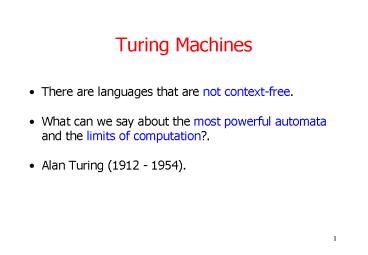Turing Machines - PowerPoint PPT Presentation
1 / 30
Title:
Turing Machines
Description:
Alan Turing (1912 - 1954). 2. Standard Turing Machine. Control unit. q0. Tape. Read-write head ... solvable by an algorithm cannot be solved by a Turing machine. ... – PowerPoint PPT presentation
Number of Views:44
Avg rating:3.0/5.0
Title: Turing Machines
1
Turing Machines
- There are languages that are not context-free.
- What can we say about the most powerful automata
and the limits of computation?. - Alan Turing (1912 - 1954).
2
Standard Turing Machine
Tape
Read-write head
Control unit q0
3
Standard Turing Machine
- M (Q, ?, ?, ?, q0, , F)
- Q finite set of internal states
- ? finite set of symbols - tape alphabet
- ? ? blank
- ? ? ? - finite set of symbols - input
alphabet - ? Q ? ? ? Q ? ? ? L, R transition function
- q0 ? Q initial state
- F ? Q set of final states
4
Standard Turing Machine
- ? Q ? ? ? Q ? ? ? L, R
current symbol
head move direction
replacing symbol
5
Example
- ?(q0, a) (q1, d, R)
current symbol
head move to the right
replacing symbol
6
Halt State
- A state for which ? is not defined.
- Assume that all final states are halt states.
7
Example
- M (Q, ?, ?, ?, q0, , F)
- Q q0, q1 ?(q0, a) (q0, b, R)
- ? a, b ?(q0, b) (q0, b, R)
- ? a, b, ?(q0, ) (q1, , L)
- F q1
8
Example
- M (Q, ?, ?, ?, q0, , F)
- Q q0, q1 ?(q0, a) (q1, a, R)
- ? a, b ?(q0, b) (q1, b, R)
- ? a, b, ?(q0, ) (q1, , R)
- F ? ?(q1, a) (q0, a, L)
- ?(q1, b) (q0, b, L)
- ?(q1, ) (q0, , L)
9
Instantaneous Description
- a1a2 ... ak-1qakak1 ... an
- current state current symbol
10
Instantaneous Description
- move abq1cd ? abeq2d
- if ?(q1, c) ? (q2, e, R)
11
Instantaneous Description
- x1qix2 ?M y1qjy2
- x1qix2 ?M y1qjy2
12
Turing Machines as Language Accepters
- Let M (Q, ?, ?, ?, q0, , F) be a TM.
- L(M) w ? ? q0w ?M x1qfx2 where qf ? F and
x1, x2 ? ?
13
Example
- L 0
- M (Q, ?, ?, ?, q0, , F) ?
14
Example
- L anbn n ? 1
- M (Q, ?, ?, ?, q0, , F) ?
15
Example
- L anbncn n ? 1
- M (Q, ?, ?, ?, q0, , F) ?
16
Turing Machines as Language Transducers
- q0w ?M qfw
- function w f(w)
17
Turing Machines as Language Transducers
- A function f with domain D is said to be
Turing-computable if there exists some Turing
machine M (Q, ?, ?, ?, q0, , F) such that - q0w ?M qff(w) qf ? F
- for all w ? D.
18
Example
- f(x, y) x y
- M (Q, ?, ?, ?, q0, , F) ?
19
Example
- f(w) ww w ? 1
- M (Q, ?, ?, ?, q0, , F) ?
20
Example
- f(x, y) true if x ? y
- or f(x, y) false otherwise
- M (Q, ?, ?, ?, q0, , F) ?
21
Combining Turing Machines
- x y if x ? y
- f(x, y)
- 0 if x ? y
- M (Q, ?, ?, ?, q0, , F) ?
22
Combining Turing Machines
x y
Adder A
x ? y
x, y
f(x, y)
Comparer C
x ? y
Eraser E
0
23
Combining Turing Machines
- qcw(x)0w(y) ?M qAw(x)0w(y) if x ? y
- qcw(x)0w(y) ?M qEw(x)0w(y) if x ? y
- qAw(x)0w(y) ?M qAfw(x y)0
- qEw(x)0w(y) ?M qEf0
24
Macroinstructions
- if a then qj else qk
- ?(qi, a) (qj0, a, R)
- ?(qi, b) (qk0, b, R)
- ?(qj0, c) (qj, c, L)
- ?(qk0, c) (qk, c, L)
25
Subprograms
Region separator
Workspace for A
Workspace for B
26
Example
- f(x, y) x ? y
- For each 1 in x, create a 1-string of length y.
27
Turing's Thesis
- Turing machine appears to be simple.
- Turing seems to approach a typical digital
computer.
28
Turing's Thesis
- Any computation that can be carried out by
mechanical means can be performed by some Turing
machine.
29
Turing's Thesis
- Anything done by existing digital computers can
be done by a Turing machine. - No problem solvable by an algorithm cannot be
solved by a Turing machine. - No alternative mechanical computation model is
more powerful than the Turing machine model.
30
Homework
- Exercises 2, 5, 8, 9, 16, 19 of Section 9.1.
- Exercises 1, 2, 3, 4, 9 of Section 9.2.
- Presentations
- Section 12.1 Computability and Decidability
Halting Problem - Section 13.1 Recursive Functions
- Post Systems Church's Thesis
- Section 13.2 Measures of Complexity
Complexity Classes































